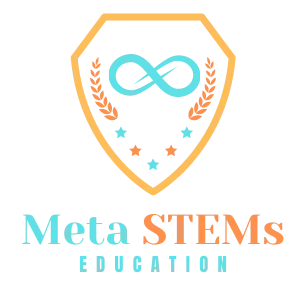July 28, 2025
Introduction:
- Hook: Start by asking a question that challenges the reader’s perception of learning. “Tired of the same repetitive questions and drills? What if you could unlock the secrets of engineering, biology, and coding right from your kitchen table?”
- Introduce the Meta STEMs Philosophy: Briefly mention that true learning isn’t about memorization but about igniting a passion for discovery. Align with the Meta STEMs goal of moving beyond traditional methods to foster genuine enthusiasm.
- State the Goal: This article provides 5 engaging STEM activities at home that do more than just entertain. They are designed to build the analytical and problem-solving skills necessary for tackling future challenges, from competitive exams like the SAT, JEE, and NEET to real-world careers1.
- Keyword Integration: Naturally weave in phrases like at-home learning and fun STEM projects.

Activity 1: The Clean Water Challenge – Engineering a DIY Filter
- Headline: Engineering for Humanity: Build Your Own Water Filter
- Introduction to the Concept: Explain that access to clean water is a global engineering challenge. This activity isn’t just a craft; it’s a small-scale simulation of the processes used in municipal water treatment plants.
- Materials Needed:
- Plastic bottle (cut in half)
- Cotton balls
- Sand
- Gravel
- Activated charcoal (from a pet store or pharmacy)
- Dirty water (mix soil and water)
- The “Meta STEMs” Twist (The Why):
- Science: Discuss the concepts of porosity and adsorption. Explain how different layers filter particles of varying sizes and how activated charcoal uses its massive surface area to chemically trap impurities.
- Engineering: This is a classic kids engineering challenge. Frame it as a design problem: How can you layer the materials for the most effective filtration? Encourage testing different designs.
Activity 2: The Power of Potential – Construct a Simple Catapult
- Headline: Unlock Physics: Design and Launch Your Own Catapult
- Introduction to the Concept: Before advanced weaponry, there was the physics of simple machines. This project explores the core principles of energy transfer and projectile motion.
- Materials Needed:
- Popsicle sticks
- Rubber bands
- A plastic spoon
- Small projectiles (marshmallows, cotton balls)
- The “Meta STEMs” Twist (The Why):
- Physics: Explain potential energy (stored in the stretched rubber bands) and its conversion to kinetic energy (the motion of the projectile). Discuss levers and fulcrums.
- Mathematics: Challenge the student to measure the launch angle and distance to calculate the projectile’s trajectory. This is a direct application of trigonometry and physics used in advanced problem-solving.
Activity 3: Unraveling Life’s Code – Extract Strawberry DNA
- Headline: The Blueprint of Life: A DIY Science Experiment to See DNA
- Introduction to the Concept: DNA is the code that makes every living thing unique. While it sounds complex, you can easily see it with this amazing experiment.
- Materials Needed:
- Strawberries
- Zip-top bag
- Dish soap
- Salt
- Rubbing alcohol (chilled)
- A clear glass or test tube
- The “Meta STEMs” Twist (The Why):
- Biology & Chemistry: This isn’t just “goop in a glass.” Explain what each ingredient does. The soap breaks down the cell membranes (fats), the salt helps the DNA strands clump together, and the cold alcohol causes the DNA to precipitate out of the solution so you can see it. This demonstrates the biochemical properties of cells.
Activity 4: From Player to Creator – Code a Simple Game with Scratch
- Headline: Master the “T” in STEM: Learn Logic by Building Your Own Game
- Introduction to the Concept: Technology isn’t just about using apps; it’s about understanding how they are made. Scratch, a visual programming language, is the perfect starting point for future coders and developers.
- Materials Needed:
- A computer with internet access
- A free account on the Scratch website
- The “Meta STEMs” Twist (The Why):
- Technology & Logic: This activity teaches computational thinking, conditional statements (if/then), loops, and debugging. Frame it as developing a logical mindset, which is critical for mathematics Olympiads and coding challenges. It’s a foundational step in at-home learning for digital natives

Activity 5: The Lemon-Powered Light – A Fresh Take on Circuits
- Headline: Spark Your Curiosity: Create a Battery from a Lemon
- Introduction to the Concept: Explore the fundamentals of electricity and chemistry by turning a simple piece of fruit into a power source.
- Materials Needed:
- A lemon
- A copper coin or wire
- A galvanized (zinc-coated) nail
- An LED light or a voltmeter
- The “Meta STEMs” Twist (The Why):
- Chemistry & Electricity: Explain that this is a simple electrochemical cell (a battery). The acidic lemon juice acts as the electrolyte, while the copper and zinc serve as the electrodes. The chemical reaction between them causes electrons to flow, creating an electrical current. Connect this to how all batteries work.
Conclusion: From Home Experiments to Global Achievements
Call to Action (CTA): “Did you enjoy these challenges? Are you ready to take your skills to the next level? Explore the Meta STEMs Olympiads and test your knowledge against students from around the world. Innovate, learn, and excel with us!”
Summarize: These fun STEM projects are more than just activities; they are exercises in innovation, critical thinking, and problem-solving.
Reinforce the Meta STEMs Vision: Emphasize that the skills developed through these hands-on tasks—analytical reasoning, scientific inquiry, and design thinking—are the very skills that create top achievers


